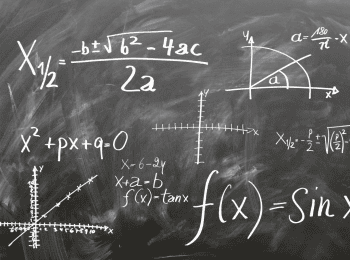Image source: Pixabay.com
You’ll encounter the square root of x graph in your calculus and geometry classes. Graph-related work is easy to understand even if you don’t have much-advanced math experience. Draw graphs to accompany equations to help you find answers without a struggle.
Learn all you can about square roots before using graphs to determine solutions to assigned problems. A square root is a number multiplied by itself. Square roots are used to take measurements of spaces and buildings. There are also many other scientific and real-world uses for square roots.
What are Square Roots?
Square roots are indicated by putting a two (commonly called squared, or multiplying the number by 2) above the number you’re multiplying.
If you calculate a number’s square root, you need to find the number that was squared in the first place. For example, three is the square root of nine. Three squared equals nine and the square root of nine equals three. All squares and square roots are displayed in pairs.
There are many different square roots, including decimal squares, perfect squares and square roots for negative numbers.
Square roots of most numbers aren’t whole and easy to determine. You probably know the square roots of four and nine by heart, but what about five or seven? The square root of seven is 2.64575131106!
You will use a calculator or table to determine most square roots. However, some teachers may want you to figure it out long-hand – or at least know the manual process for determining odd square roots.
You can figure out square roots by hand by:
-
Adding a zero to the front of numbers with an odd amount of digits before the decimal place
-
Adding a zero to the end if there is an odd number of digits behind the decimal place
-
Making sure you have an even number of digits to work with
Once you’ve adjusted the numbers, draw an area diagram and use it to determine the square root. You probably won’t need to use this method often, but it will help you understand the method behind determining square roots. Your teacher may recommend other manual methods.
Square roots are used by factory workers, engineers, and scientists. Square roots are used to calculate volume and area. When you are looking for a new house or apartment, square roots help you determine the real size of a room. A 400 square foot apartment equals 20 feet by 20 feet, for example.
Carpenters use square roots to determine building and room measurements.
Graphs
You can draw graphs on your computer or Smartphone. Go old-school and use graph paper or a calculator to solve problems if you prefer. A visual representation of the equation always helps you to calculate the answer more efficiently.
Define the variable in your equation and locate the point on your graph for the function. Buy a graphing calculator if you need to solve lots of square root graphing problems. A graphing calculator shows plotted graphs and has tangent, sine and cosine capabilities. You can buy these calculators online or at Staples or Office Depot.
Example #1
Here’s an example of how to find the square root of x graph that involves a table. Determine the domain for this equation, determine the table for the values of the f function, and graph it. Then figure out the range.
The equation is: f(x) equals the square root of (x squared negative 9). Find the function’s domain with x squared negative 9 is greater than or equal to zero. The domain is shown by negative 00, negative 3 U (3 plus 00).
Now find values of x in the f domain and make a table of values. Consider that f(x) equals f (negative x). Check the graph symmetry and the y-axis to determine the answer.
F’s range is indicated by (0 plus 00).
Example #2
Determine the graph for the radicand (the number under the radical symbol) and devise a table of values of function f, and graph f and determine its range.
F(x) equals the square root of x squared plus 4x plus 6. You complete the square by rewriting the numbers under the square root as follows:
X squared plus 4x plus six equals (x plus 2) squared plus 2
The expression underneath the square root is positive. Therefore, f’s domain consists of all real numbers. The graph of (x plus 2) squared plus 2, or a parabola. The graph of f has the same axis of symmetry. X equals two the vertical line, is above the graph. The table of graphs can be written numerically as:
X equals the square root of (x plus two squared plus 2). On the graph, negative 2 equals 1.4, zero equals 2.4, two equals 4.2, and four equals 6.2
The f range is shown by the interval the square root of 2 plus 00.
Example #3
Here’s something a little different. Show the graph of y equals the square root of x minus one plus two as an extension of the parent graph y equals the square root of x.
Draw a graph representing y equals the square root of x. Then move the graph a unit to the right, and you’ll get y equals the square root of x minus one. Move the graph of y equals the square root of one up two units, and you’ll get y equals the square root of x minus one plus two.
The visual representation of the graph makes it easy to see the answers. Now you can figure that x is greater than or equal to one is the domain of the function y equals the square root of x minus one plus two.
The graph also shows the range of the function y equals the square root of x minus one plus two is greater than or equal to two.
How to Study
Most people have a hard time studying for calculus, geometry or algebra exams. Most problems can be attributed to math anxiety, a common classroom ailment. Math is only hard if you think it is – like any other subject, your attitude will make or break your study habits.
Whether you are studying how to find the square root of x graph or something else, you’ll encounter obstacles if you don’t break down the process into manageable steps.
All-nighters won’t garner the best results in any school subject, and math is the hardest subject of all for last-minute study. Plan your study schedule even if you don’t have a test coming up – daily study is the only way to familiarize yourself with calculus formulas and definitions.
Make sure you get enough sleep and eat right, especially the day before an exam. If you’re bleary-eyed and running on caffeine and sugar, you won’t be able to concentrate on the formulas and terms you need to solve problems.
You build on one theory and set of formulas in algebra, geometry or calculus before you can move on to another, more complicated aspect of advanced math. You won’t get answers on the first try unless you’re a math genius or you’re working on simple problems. Be prepared for some trial and error.
You have several options besides solo study and reviewing class notes to help you study. Need extra help? Consider the following options:
There are many video tutorials on YouTube and math websites to help you if written explanations are confusing. Check websites for colleges and universities, as many math departments include PDFs of handouts from some of their math classes.
Don’t ignore concepts or problems you don’t understand and move onto another lesson. You need to fully grasp one concept before moving on to the next chapter or function. Practice on as many problems as you can, and pinpoint where you made the error in your thinking.
Always ask your teacher, tutor or classmates to help you find real-life applications for math problems. When you are aware of how to use calculus or other math formulas in the real world, you’ll be less apt to have math anxiety or complain that calculus is useless and won’t help you when you graduate.
Calculus is used in manufacturing, science, engineering, astronomy, aviation, and other industries. Try to find “common ground” with your math assignments. Look for how you can use the formulas in your daily life, or a hobby or your chosen field.
Keep in mind that most math and calculus problems can be solved in several different ways. There might be a second or third way if one method is hard for you to understand. If your book or teacher only suggests one way to solve a problem, look for other methods online or ask a friend about alternate methods.
Control your math anxiety by having a set schedule for homework. Always have at least one other trustworthy person to help you review assignments and help you study for tests. Keep a positive attitude about math classes; don’t dread them.
Be open to new study methods and learn about practical ways to use calculus and other advanced math in your life outside the classroom.
Featured Image by Gerd Altmann from Pixabay
The video may take a few seconds to load.
Having trouble Viewing Video content? Some browsers do not support this version – Try a different browser.






